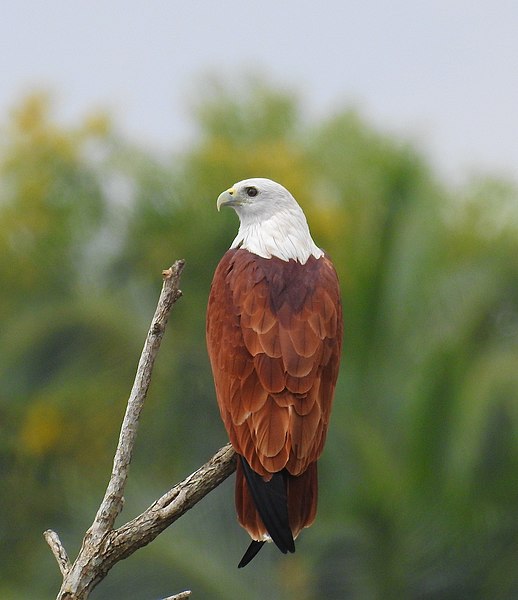Brahminy Kite Bird Details
Haliastur indus
Brahminy Kite,Red-backed Sea-eagle, Haliastur;
Brahmani Chil
Pieter Boddaert, 1783
Accipitriformes (HAWKS, EAGLES and KITES)
Accipitridae
Accipiter
India(Maharashtra, Gujarat, Kerala, Tamil Nadu, and the Andaman and Nicobar Islands.), Bangladesh, Myanmar, Thailand, Vietnam, Indonesia, Malaysia, and Australia.
Appearance :
Adults have a distinctive reddish-brown body with a white head and neck. Dark brown wings with white patches at the base and white tail feathers. Juveniles are darker with more mottled plumage.
Behaviour :
Characterized by a graceful soaring flight, often seen gliding effortlessly on thermal currents. Generally solitary or found in pairs, often observed near water bodies.
Habitat :
Coastal areas, estuaries, and wetlands; commonly seen near rivers, lakes, and mangroves.
Diet :
Fish, small mammals, crustaceans, and carrion. Often hunts by soaring high and spotting prey from above before diving to catch it.
Conservation Status :
Least Concern
Distribution :
Found across South and Southeast Asia, including parts of Australia.
Population Size :
The global population of the Brahminy kite (Haliastur indus) is estimated to be more than 100,000 individuals.
Life Span :
Typically 15-20 years in the wild.
Body And Tarsus:
- Body: The Brahminy Kite has a robust body with a strong build. It exhibits sexual dimorphism, with females generally larger than males.
- Tarsus Length: Approximately 7.5 to 9 cm, depending on the individual.
Head And Bill :
- Head: The head is relatively small and rounded, covered with white feathers that contrast with the darker body.
- Bill: Strong and hooked, typical of raptors.
- Bill Length: About 4.5 to 5 cm.
Length :
Ranges from 50 to 60 cm (about 19 to 24 inches).
Neck :
Short and stout, connecting the head to the body, with white feathers extending down from the head.
Size :
Medium-sized raptor, robust and well-adapted for soaring.
Tail Details :
- Tail: Short to medium-length tail that is slightly rounded.
- Tail Length: About 20 to 25 cm.
- Feathers: The plumage is primarily reddish-brown with a distinctive white head and neck. The tail features white markings and the wings have dark brown coloration with white patches at the base.
Weight :
Weighs between 1.2 to 2.0 kg.
Wing :
Wings are broad with long primary feathers, enabling efficient soaring. The wing shape is slightly rounded at the tips, aiding in gliding over water bodies.
Wing Span :
Typically ranges from 1.4 to 1.5 meters
Facial Feature :
The facial features include a white crown and face, with a distinct contrast against the dark brown body, contributing to its striking appearance.
Nest Details :
- Nest: Nests are large, bulky structures often built high in tall trees or cliffs, providing a good vantage point.
- Nest Made Up Of: Composed of twigs, branches, and various plant materials. They may also incorporate debris such as plastic and other human-made materials.
Breeding Season :
Typically occurs between January and August.
Nesting Season :
Varies regionally but commonly peaks in March to May.
Egg Color :
The eggs are generally white to pale bluish with speckles or blotches of brown.
Egg Length :
Approximately 4.5 to 5.5 cm.
Egg Width and Weight :
- Egg Width: About 3.5 to 4.5 cm.
- Egg Weight: Each egg weighs around 40 to 50 grams.
Clutch Size :
Typically consists of 1 to 3 eggs, with 2 eggs being the most common.
No. of Broods :
Usually raises one brood per breeding season, though some pairs may attempt a second brood if conditions are favorable.
Incubation Period :
Lasts around 30 to 35 days.
Nestling Period :
Young birds fledge approximately 45 to 60 days after hatching.
Vocalization :
Vocalizations consist of a series of high-pitched whistles and calls.
Sex Demorphism :
Females are generally larger.
Migration Details :
Migration Pattern: Brahminy Kites are generally sedentary but may undertake local migrations in search of food or favorable breeding conditions.
Migration Period: If migrating, movements may occur between September and November, aligning with seasonal changes in prey availability.
Migration Route: The species typically migrates short distances, following coastlines or river systems where food sources are abundant.
